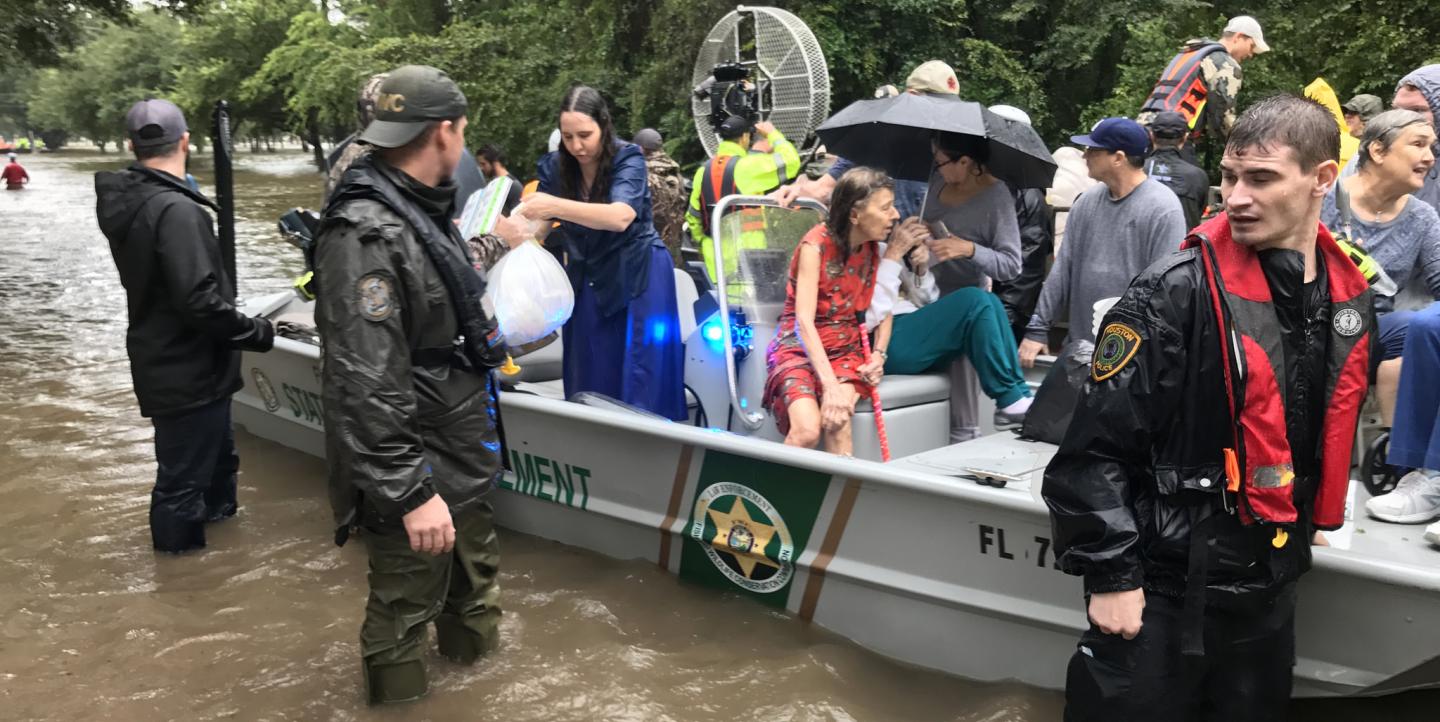The video, shot in the wake of Hurricane Harvey, was stunning: A semi-truck was marooned in rapidly rising floodwaters with the driver trapped inside. Water had begun flowing into the cab when a reporter, broadcasting from a nearby roadway, noticed the alarming scene.
Standing in the rain, she shouted, “Sir, are you ok?” then flagged down a rescue vehicle with boat in tow. The cameraman filmed the driver being pulled out through a window.
The story, aired on Houston’s KHOU-TV, went viral: “Houston reporter helps save stranded truck driver,” reported CBS News. The Huffington Post credited the reporter with "leading rescuers to truck driver trapped in 10 feet of water.” A headline from the Daily Beast read, “Houston TV crew saves truck driver’s life.”
The quick action by KHOU’s Brandi Smith became an integral part of the newscast.
KHOU has evacuated the studios. The roads were so bad I couldn't get in to work. But @BrandiKHOU is still on for us!#KHOU11 pic.twitter.com/QKHs26TL7I
— Ron Trevino (@khouron) August 27, 2017
What occurred in Houston that Sunday morning touches on a longstanding debate about whether reporters should put aside notebooks and cameras and help those in need.
Media professionals traditionally abide by the maxim: seen but not heard. Yet, it is human nature to want to help someone who is suffering or in peril. Observer or participant: Where do we draw the line?
In a September blog posting, Patrick L. Plaisance, editor of the Journal of Media Ethics, described the media’s role of bearing witness as “a moral imperative deeply embedded in journalistic DNA . . . stepping out of that role should not be taken lightly.”
He pointed to Hurricane Harvey coverage where, at times, reporters assisted rescuers, lifting flood victims into boats and helping them out of submerged houses with cameras rolling.
“If they really felt obligated to help, they should have turned off the camera until they were ready to resume working as journalists. Otherwise, it can look like moments of self-aggrandizement, rather than critical, moral response,” said Plaisance.
He suggests two factors to consider: the nature of the danger and whether the media’s assistance is critical to safety. Plaisance viewed Smith’s intervention as the latter.
“What happened there was much more impromptu," he said. "Clearly the situation looked serious and there was no help coming until [the reporter] flagged down the sheriff’s truck and directed rescuers to the trapped driver. I have absolutely no problem with that."
An August story in Business Insider described first responders being overwhelmed and journalists pitching in to help. In one instance, CNN correspondent Ed Lavandera asked to cut the feed while he and other members of his TV crew brought a stranded elderly woman onto their boat.
“People who are being rescued from their houses don’t usually expect a full camera crew, much less a national camera crew,” Lavandera told Business Insider. “It’s a question of dignity.” In other instances, CNN focused on rescues their news team participated in.
Each situation is different and there are no uniform answers. IJNet searched out guidelines that can help with decision making.
Gene Foreman, author of “The Ethical Journalist: Making Responsible Decisions in the Digital Age,” notes that, over the years, journalism practitioners and scholars have reached a consensus: Media professionals should act to save a life or prevent injury if they are the best or only person in a position to intervene.
In his book, he lists four questions:
- Is the danger imminent?
- Is the danger profound?
- Is there anyone else present who can help?
- Do you, the journalist, possess special skills needed in the situation?
Foreman also offered insight from Rachel Smolkin, a reporter who wrote about journalists who intervened during Hurricane Katrina in August 2005. Among her advice:
- Follow your conscience. Your humanity – your ability to empathize with pain and suffering and your desire to prevent it – does not conflict with your professional standards. Those impulses make you a better journalist, more attuned to the stories you are tasked with telling.
- If you change an outcome through responsible and necessary intervention because there’s no one else around to help, so be it. Tell your bosses, and when it’s essential to a story, tell your readers and viewers, too
- Remember, though, that your primary – and unique – role as a journalist is to bear witness. If you decide to act, do so quickly then get out of the way.
Smolkin told how journalists covering Katrina “showed compassion by offering water, rides and rescue, but their most enduring service was to expose the suffering of citizens trapped in hellish shelters and on sweltering interstates and to document the inexcusable government response.
“Without journalists fulfilling that essential role, the resources to help on a larger scale might never have arrived.”
Roger Simpson, co-author of “Covering violence: A guide to ethical reporting about victims and trauma,” and a founding director of the Dart Center for Journalism and Trauma, expresses a similar sentiment.
“The journalist, like any human being, should prevent or minimize harm if it is in her or his capacity to do so. When the need is overwhelming and little is being done, small actions may keep the journalist in a moral and emotionally healthy relationship to the event she is covering.
“Understand that holding the camera or recording what you see and hear may be the most effective way of intervening.”
Main image CC-licensed by Flickr via Florida Fish and Wildlife.


